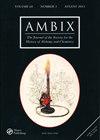Biographical Histories of Chemistry
IF 0.3
3区 哲学
Q3 HISTORY & PHILOSOPHY OF SCIENCE
引用次数: 0
Abstract
As Mary Jo Nye noted in an essay in the first issue of Bulletin for the History of Chemistry, the genre of biography maintains a great appeal among general readers, working chemists, and scholars of the academic community. The two books under review belong to this broad and increasingly popular genre of biography of chemists and they are both published by the Springer company. However, otherwise they are quite different and for this reason they will be dealt with separately. Some Forgotten Chemists is a slim volume sold by Springer at an unreasonably high price as part of the series Perspectives on the History of Chemistry, edited by Seth Rasmussen. It consists of seventeen chapters, sixteen of which describe the life and career of a chemist who is claimed to be forgotten or is little known today (one of the chapters is a summary account of “Women Pioneers” in general). The author is Brian Halton, a British-New Zealand chemist who, from 1968 to his death in 2019, worked at the Victoria University of Wellington, where he wrote a series of articles on little-remembered yet significant chemists in the local journal Chemistry in New Zealand. These biographical articles have now been collected into a book format. Somewhat unimaginatively, they appear in alphabetical order, starting with Carl Friedrich Accum and ending with William John Young. In this way each chapter is self-contained, much like in biographical dictionaries such as the authoritative multi-volumeDictionary of Scientific Biography or, to mention a less ambitious example from the history of chemistry, the Lexikon bedeutender Chemiker published in 1989. The obvious disadvantage of this kind of fragmented structure is that the book loses coherence and a common context. It is not possible to compare the separate chapters, nor is that the purpose of dictionary-like publications of this type.化学传记史
正如玛丽·乔·奈在第一期《化学史公报》上的一篇文章中所指出的那样,传记类型在普通读者、在职化学家和学术界学者中保持着巨大的吸引力。正在审查的两本书属于这一广泛且越来越受欢迎的化学家传记类型,它们都由施普林格公司出版。然而,除此之外,它们是完全不同的,因此它们将被单独处理。《一些被遗忘的化学家》是施普林格以不合理的高价出售的一本薄薄的书,是赛斯·拉斯穆森编辑的《化学史透视》系列的一部分。它由十七章组成,其中十六章描述了一位被遗忘或今天鲜为人知的化学家的生活和职业生涯(其中一章是对“女性先锋”的概述)。作者是英国-新西兰化学家布莱恩·哈尔顿,从1968年到2019年去世,他在惠灵顿维多利亚大学工作,在新西兰当地杂志《化学》上写了一系列关于鲜为人知但意义重大的化学家的文章。这些传记文章现在已被收集成书的形式。有些缺乏想象力的是,它们按字母顺序出现,从卡尔·弗里德里希·阿库姆开始,到威廉·约翰·杨结束。这样,每一章都是独立的,就像传记词典中一样,比如权威的多卷本《科学传记词典》,或者,更不用说化学史上一个不那么雄心勃勃的例子,1989年出版的《Lexikon bedeutender Chemiker》。这种支离破碎的结构的明显缺点是,这本书失去了连贯性和共同的背景。不可能比较单独的章节,这也不是这类字典式出版物的目的。
本文章由计算机程序翻译,如有差异,请以英文原文为准。
求助全文
约1分钟内获得全文
求助全文
来源期刊

Ambix
HISTORY & PHILOSOPHY OF SCIENCE-
CiteScore
0.80
自引率
60.00%
发文量
42
审稿时长
3 months
期刊介绍:
Ambix is an internationally recognised, peer-reviewed quarterly journal devoted to publishing high-quality, original research and book reviews in the intellectual, social and cultural history of alchemy and chemistry. It publishes studies, discussions, and primary sources relevant to the historical experience of all areas related to alchemy and chemistry covering all periods (ancient to modern) and geographical regions. Ambix publishes individual papers, focused thematic sections and larger special issues (either single or double and usually guest-edited). Topics covered by Ambix include, but are not limited to, interactions between alchemy and chemistry and other disciplines; chemical medicine and pharmacy; molecular sciences; practices allied to material, instrumental, institutional and visual cultures; environmental chemistry; the chemical industry; the appearance of alchemy and chemistry within popular culture; biographical and historiographical studies; and the study of issues related to gender, race, and colonial experience within the context of chemistry.
 求助内容:
求助内容: 应助结果提醒方式:
应助结果提醒方式:


